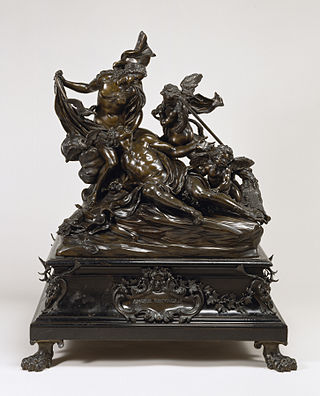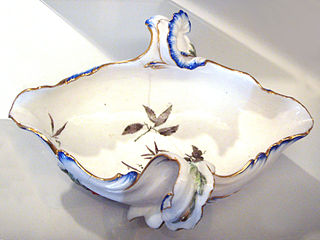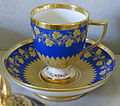
Porcelain is a ceramic material made by heating raw materials, generally including kaolinite, in a kiln to temperatures between 1,200 and 1,400 °C. The greater strength and translucence of porcelain, relative to other types of pottery, arises mainly from vitrification and formation of the mineral mullite within the body at these high temperatures. End applications include tableware, decorative ware such as figurines, and in technology and industry such as electrical insulators and laboratory ware.

The Palazzo Pitti, in English sometimes called the Pitti Palace, is a vast, mainly Renaissance, palace in Florence, Italy. It is situated on the south side of the River Arno, a short distance from the Ponte Vecchio. The core of the present palazzo dates from 1458 and was originally the town residence of Luca Pitti, an ambitious Florentine banker.

The Vincennes porcelain manufactory was established in 1740 in the disused royal Château de Vincennes, in Vincennes, east of Paris, which was from the start the main market for its wares.

Soft-paste porcelain is a type of ceramic material in pottery, usually accepted as a type of porcelain. It is weaker than "true" hard-paste porcelain, and does not require either the high firing temperatures or the special mineral ingredients needed for that. There are many types, using a range of materials. The material originated in the attempts by many European potters to replicate hard-paste Chinese export porcelain, especially in the 18th century, and the best versions match hard-paste in whiteness and translucency, but not in strength. But the look and feel of the material can be highly attractive, and it can take painted decoration very well.
Sir Geoffrey de Bellaigue was Surveyor of the Queen's Works of Art from 1972 to 1996. His was the first full-time appointment to the office, and he did much to professionalise the Royal Collection department after being made the Director of the Royal Collection in 1988.

The Museum of Zoology and Natural History, best known as La Specola, is an eclectic natural history museum in Florence, central Italy, located next to the Pitti Palace. The name Specola means observatory, a reference to the astronomical observatory founded there in 1790. It now forms part of the Museo di Storia Naturale di Firenze. This museum is part of what are now six different collections at four different sites for the Museo di Storia Naturale di Firenze.

Massimiliano Soldani or Massimiliano Soldani Benzi was an Italian baroque sculptor and medallist, mainly active in Florence. Born at Montevarchi, the son of a Tuscan cavalry captain, Soldani was employed by the Medici for his entire career.

Medici porcelain was the first successful attempt in Europe to make imitations of Chinese porcelain, though it was soft-paste porcelain rather than the hard-paste made in Asia. The experimental manufactory housed in the Casino of San Marco in Florence existed between 1575 and 1587 under the patronage of Francesco I de' Medici, Grand Duke of Tuscany. Surviving examples are extremely rare, numbering 59 according to the Metropolitan Museum of Art.

The Doccia porcelain manufactory, at Doccia, a frazione of Sesto Fiorentino, near Florence, was in theory founded in 1735 by marchese Carlo Ginori near his villa, though it does not appear to have produced wares for sale until 1746. It has remained the most important Italian porcelain factory ever since.

A ceramics museum is a museum wholly or largely devoted to ceramics, usually ceramic art. Its collections may also include glass and enamel, but typically concentrate on pottery, including porcelain. Most national collections are in a more general museum covering all of the arts, or just the decorative arts. However, there are a number of specialized ceramics museums, with some focusing on the ceramics of just one country, region or manufacturer. Others have international collections, which may be centered on ceramics from Europe or East Asia or have a more global emphasis.

French porcelain has a history spanning a period from the 17th century to the present. The French were heavily involved in the early European efforts to discover the secrets of making the hard-paste porcelain known from Chinese and Japanese export porcelain. They succeeded in developing soft-paste porcelain, but Meissen porcelain was the first to make true hard-paste, around 1710, and the French took over 50 years to catch up with Meissen and the other German factories.

Jean-Claude Chambellan Duplessis, called Duplessis père to distinguish him from his son, Jean-Claude-Thomas Chambellan Duplessis, was a goldsmith, sculptor and ceramics modeller, bronze-founder and decorative designer working in the Rococo manner. He served as artistic director of the Vincennes porcelain manufactory and its successor at Sèvres from 1748 to his death in 1774 and as royal goldsmith from 1758 to 1774.

The Marton Museum is Croatia's first private museum and specializes in 18th and 19th century European applied art. The Marton Museum derives its name from its original founder, Veljko Marton, whose collection is featured within its walls.

Pot pourri à vaisseau or pot pourri en navire is the shape used for a number of pot-pourri vases in the form of masted ships, first produced between the late 1750s to the early 1760s by the Sèvres manufactory near Paris. The colours and details of the painted decoration vary between examples, as is typical of Sèvres porcelain, and one example is on a later gilt wood stand. The openwork lid lifts off to allow refilling of the pot-pourri. The shape was eventually produced in two or three versions, at slightly different sizes. It was first designed in 1757, probably by Jean-Claude Duplessis, the artistic director of the factory. The first surviving finished example dates to 1759. Another name for them is vaisseau à mat.
Porcelain Museum may refer to:
Alessandro Vezzosi is an Italian art critic, Leonardo scholar, artist, expert on interdisciplinary studies and creative museology, he is also the author of hundreds of exhibits, publications and conferences, in Italy and abroad on Leonardo da Vinci and the Renaissance, contemporary art and design. Amongst others, he was the first scholar from the Armand Hammer Centre for Leonardo Studies from the University of California in Los Angeles (1981), directed by Carlo Pedretti; he taught at the University of Progetto in Reggio Emilia; and he is honorary professor at the Accademia delle Arti del Disegno of Florence. He began as an artist from 1964 to 1971 winning more than 80 prizes in painting competitions. In the Seventies he was the founder of the "Archivio Leonardisimi" and of Strumenti-Memoria del Territorio; he coordinated "ArteCronaca", he was the historical-artistic consultant of the Municipality of Vinci and he collaborated on the publications on Tuscany and Leonardo, modern and contemporary art. In 1980 he curated the Centro di Documentazione Arti Visive of the Municipality of Florence.
Jafet Torelli was an Italian ceramist and sculptor.

The National Museum of Ceramics Duca Di Martina is a historical and artistic site situated inside of the Villa Floridiana Park in Naples, Italy. The building used to be one of Campania’s Bourbon royal residences and since 1927 this residence has hosted the museum.

The Reale Museo di Fisica e Storia Naturale was an Italian museum founded on 22 February 1775 in Florence that survived until 1878, when its collections were split up in various Florentine museums.

Cozzi porcelain is porcelain made by the Cozzi factory in Venice, which operated between 1764 and 1812. Production included sculptural figurines, mostly left in plain glazed white, and tableware, mostly painted with floral designs or with figures in landscapes and buildings, in "bright but rough" colours. They were rather derivative, drawing from Meissen porcelain in particular in the early years.

























